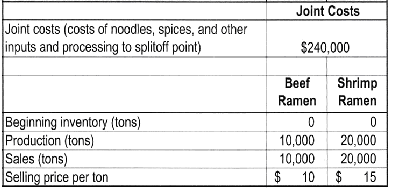Joint-cost allocation, sales value, physical measure, NRV methods. Instant Foods produces two types of microwavable productsbeef-flavored ramen
Question:
Joint-cost allocation, sales value, physical measure, NRV methods. Instant Foods produces two types of microwavable products—beef-flavored ramen and shrimp-flavored ramen. The two products share common inputs such as noodle and spices. The production of ramen results in a waste product referred to as stock, which Instant dumps at negligible costs in a local drainage area. In June 2009, the following data were reported for the production and sales of beef-flavored and shrimp-flavored ramen:

Due to the popularity of its microwavable products, Instant decides to add a new line of products that targets dieters. These new products are produced by adding a special ingredient to dilute the original ramen and are to be sold under the names Special B and Special 5, respectively. The following is the monthly data for all the products:

1. Calculate Instant’s gross-margin percentage for Special B and Special S when joint costs are allocated using:
a. Sales value at splitoff method
b. Physical-measure method
c. Net realizable value method
2. Recently, Instant discovered that the stock it is dumping can be sold to cattle ranchers at $5 per ton. In a typical month with the production levels shown above, 4,000 tons of stock are produced and car sold by incurring marketing costs of $10,800. Sherrie Dong, a management accountant points out that treating the stock as a joint product and using the sales value at splitoff method, the stock product would lose about $2,228 each month, so it should not be sold. How did Dong arrive at that final number, and what do you think of her analysis? Should Instant sell the stock?
Step by Step Answer:

Cost Accounting A Managerial Emphasis
ISBN: 978-0136126638
13th Edition
Authors: Charles T. Horngren, Srikant M.Dater, George Foster, Madhav





